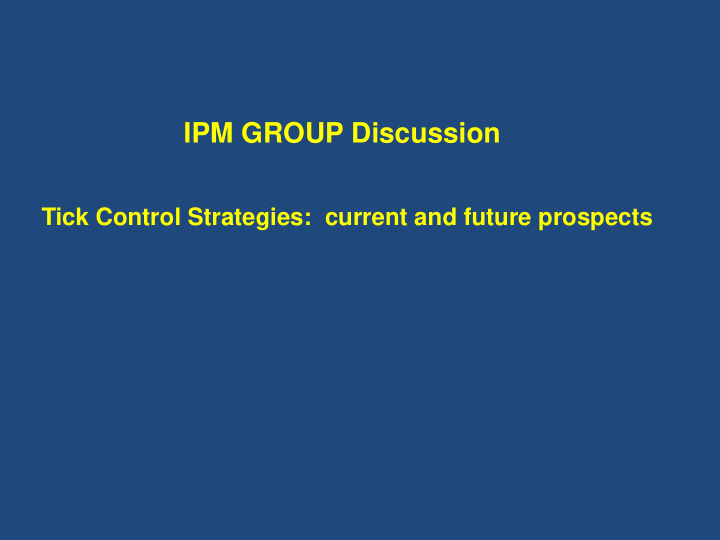



IPM GROUP Discussion Tick Control Strategies: current and future prospects
Tick Control Inventions and Products Attract and Kill Methods Tick Decoy. Pheromone-acaricide impregnated plastic beads applied to pet animals and livestock. Tail Tag Decoy. Pheromone-acaricide impregnated plastic collar applied to tails of cattle, other ruminants. SPLAT-TK Spray. Pheromone-acaricide impregnated oily droplets (dollops) dispersed onto vegetation.
velcro Tick decoy
Host-targeted tick control technologies 4-Poster for killing ticks on deer Damminix Tick Tubes Marketed by ECOHEALTH, INC., 56 Hawes Street Brookline, MA 02446 Phone 617.742.2400; Fax 617.849.5494 www. Ticktubes.com A patented device developed by USDA, ARS scientists to protect white-tailed deer from blacklegged ticks is now being sold commercially. The American Lyme Disease Foundation, Somers, NY, was licensed to produce the device, called the "4-Poster" Deer Treatment Bait Station, developed by ARS scientists in Kerrville, Texas. Mixed success, not accepted in all locations, concern about use during Permethrin-impregnated cotton balls hunting season, etc. collected by mice to use for nesting materials. Kills immature ticks
ROBOTICS – Semi-autonomous tick killing robot Deploy Tickbot U.S. Patent US20060204531A1] Scour environment, collect and kill ticks. 100% kill lone star ticks > 24 h in trails and meadows in field trials Alternative use: dispense odorant/pheromone – deposit in vegetation.
GENETICS TARGETING TICK GENES FOR TICK CONTROL NATURE COMMUNICATIONS publication (2-9-2016): Genomic insights into the Ixodes scapularis tick vector of Lyme disease By Monika Gulia-Nuss et al. I. scapularis genome sequence comprises 1.8 Gbp of which 57% was annotated. Predicted 20,486 protein-coding genes, and 4,439 non-coding RNA genes. Exploring the tick genome and the (corresponding) transcriptomes of tick organs yields an enormous array of highly specialized gene targets that could be selected for suppression (RNAi) or deletion ( CRISPR/Cas9 kit ) .
TARGETING TICK GENES FOR TICK CONTROL (continued Chemoreception: host and mate recognition Odorant detection by olfactosensilla in Haller’s organ on foreleg tarsi Candidate odorant receptor (OR) genes include GPCRs ( G protein-coupled receptors) and IR/iGluR ( ionotropic glutamate related receptors ). Almost all are novel (few insect- related orthologs). Also includes one member of ancestral chemosensory protein (CSP ) family. Excellent targets for gene editing, RNAi, etc., to disrupt host finding and mating .
TARGETING TICK GENES FOR TICK CONTROL (continued) Salivary glands Tick specific salivary genes: Genes encoding Kunitz domain proteins: protease inhibition, coagulation, angiogenesis, vasodilation..etc . Ticks have 74 kunitz domain proteins , 0.4% of the entire genome, probably most of any known haematophagous arthropod. Genes encoding lipocalins : anti-inflammatory activity & other anti-hemostatic roles. Ticks have an unusually high number of such proteins. Blood feeding and hemoglobin digestion Hemoglobin ingestion intracellular, within specialized vesicles. Digestion occurs via a cascade of proteolytic enzymes, liberating dipeptides and free amino acids and disseminated via hemolymph throughout the body. Genes encoding for cathepsin D (three genes), cathepsin L (three genes), and serine carboxypeptidase (four genes) critically important for digestion. Haem from digestion detoxified in unique vesicles (small amounts transported elsewhere and incorporated into vitellogenin and CP
TARGETING TICK GENES FOR TICK CONTROL (continued) Blood feeding and hemoglobin digestion Blood sucking – neuropeptides and neurotransmitters regulating pharyngeal pump. qPCR assasy of neurotransmitter receptors in syngnanglion from fed v. unfed females shows strong upregulation of glutamate (stimulates) versus weak or no regulation GABA (inhibits) consistent with action of pharyngeal pumping during feeding. From Egekwu et al. (2016)
TARGETING TICK GENES FOR TICK CONTROL (continued) Disease transmission – TROPSA (Tick Receptor outer surface protein A) full sequence known. Candidate for gene deletion via CRISPR/case Defensins- antimicrobial peptide (scapularisin) – sequence known Toll receptors, IMD pathway and JAKSTAT pathway: upregulation genes in these pathways believed trigger phagocytic hemocytes to phagocytose migrating spirochetes, other bacteria. Salp 15, Salp 20, TSLP1 and tHRE facilitate transmission via tick saliva into host body.
TRANSGENIC TICKS Prospects for disruption disease transmission and tick population control Transgenic mosquitoes – model system may also be applied to ticks and tick-borne diseases. Done in mosquito by injecting embryos, fusing genes, other methods. Examples: 1. Gentile et al. (2015) Malaria J. 2015 22: 14:92. Using sterile insect technique (SIT) to release mosquitoes with dominant lethal, homing endonuclease genes; release of transgenic male mosquitoes, mate with wild females produce either no viable offspring. Testing in progress for field use. 1. Marinotti et al. (2013) Malaria J. 12: 142. Created population of genetically engineered anopheline mosquitoes in which progeny matured to flightless females. Easily reared in lab and mass produced for release into field. 2. Isaacs, A.T. et al. (2012) PNAS 109(28):E1922-30. Genetically engineered population of A. stephensi with genes encoding antibodies that eliminated sporozoites and prevent malaria transmission; no fitness cost.
TRANSGENIC TICKS (continued Can we create transgenic ticks? Tick biology many features similar to mosquitoes (numerous large eggs, single mating, etc. Costs Ethical considerations FUTURE DISCUSSIONS
Recommend
More recommend